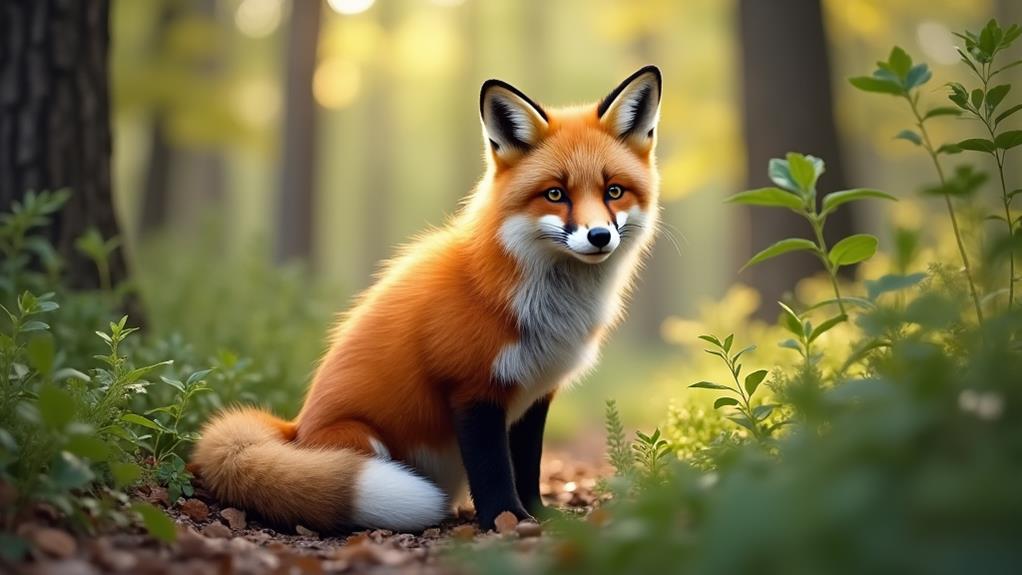You might get excited thinking about a red fox and a white fox hybrid, but it turns out that nature has other plans! Red foxes and Arctic foxes are just too genetically different. They simply can't mix due to their separate chromosome structures, which prevents them from producing viable hybrids. While some hybrids have been created in captivity, they're usually sterile and can't reproduce. If that sounds rather un-fun, don't worry! These rare hybrids have fascinating traits, and there's so much more to discover about them and their unique characteristics. Isn't nature just full of surprises?
Contents
- 1 Genetic Barriers to Hybridization
- 2 Overview of Red and Arctic Foxes
- 3 Documented Fox Hybrids
- 4 The Role of Captivity
- 5 Characteristics of Hybrid Foxes
- 6 Misunderstandings About Fox Hybrids
- 7 Implications for Wildlife Conservation
- 8 Popularity in the Exotic Pet Trade
- 9 Historical Accounts of Hybridization
- 10 Final Thoughts
Genetic Barriers to Hybridization

Hybridization often faces complex genetic barriers, and the case of the red fox and Arctic fox exemplifies this challenge. Though they belong to the same genus, these two species differ notably in their genetic makeup.
You see, red foxes have 36 chromosomes, while Arctic foxes have a different structure. This genetic difference is like a brick wall preventing the formation of hybrids between them.
Imagine trying to fit two puzzle pieces that just don't match. It leads you to realize that despite sharing habitats in the wild, they simply won't interbreed naturally.
Even scientists have done experiments, and they haven't found any successful hybridization—talk about a reproductive isolation! This lack of viable hybrids not only showcases their unique qualities but also aligns with what we understand about species that are far apart genetically.
Overview of Red and Arctic Foxes
Let's take a moment to compare the red and Arctic foxes; they're quite the pair!
While the red fox struts around with its bushy tail and vibrant fur in various places, the Arctic fox keeps cozy in cold regions, sporting a thick coat that changes with the seasons.
Both species demonstrate remarkable adaptability to their environments, with the red fox thriving in a wide range of habitats, including urban areas and parks, while the Arctic fox is adept at surviving in the frigid tundra their habitats and distribution.
Despite their differences in size, weight, and behavior, both have adapted beautifully to their unique homes—almost like two siblings finding their own way in the world!
Physical Characteristics Comparison
When comparing the physical characteristics of red and Arctic foxes, you'll notice distinct features that reflect their adaptations to different environments. Both species are fascinating!
Arctic foxes possess a thick, double-layered fur that provides insulation against harsh temperatures, while red foxes tend to have a less dense coat suited for milder climates. Here are some key differences that make each unique.
- Fur Color: Red foxes flaunt a vivid reddish-brown coat, while Arctic foxes sport a thick, white coat that changes color in warmer months.
- Size: Red foxes typically weigh between 4.1 to 8.7 kg, making them larger than their Arctic counterparts, who average around 3 to 9 kg.
- Skull Shape: The red fox has a light, slender skull, but the Arctic fox has a rounder, broader skull designed for the cold.
- Eye Adaptation: Red foxes boast vertically slit pupils for better vision during hunts, while Arctic foxes have similar adaptations for seeing in the dark, chilly winters.
- Fur Density: Arctic foxes have a double-layered coat to keep them warm, while red foxes' fur is less dense, making them more suited for milder climates.
As you can see, these amazing adaptations help each fox thrive in their unique habitat.
These adaptations enhance their survival in different environmental challenges. Isn't nature incredible?
Habitat and Behavior Differences
The habitats and behaviors of red and Arctic foxes showcase their unique adaptations to survival. Red foxes are quite the social butterflies of the fox world, living in forests, grasslands, and even urban areas, where their resilience contributes to thriving populations.
These clever creatures are mainly nocturnal, doing their best snacking under the cover of night, utilizing effective foraging techniques in various settings, including urban habitats.
Meanwhile, Arctic foxes, the ultimate cold-weather experts, are perfectly suited for frigid Arctic regions and tundras. They rely heavily on small mammals to get through the seasons, showcasing their scavenging skills like pros!
When it comes to family life, red foxes can be solitary or buddy up in family groups, while Arctic foxes prefer the monogamous route, snuggling up together and providing serious parenting support to their little ones. You might appreciate their cozy bond on chilly evenings!
In terms of looks, red foxes flaunt a colorful fur coat, perfect for blending into various environments. On the flip side, Arctic foxes go full chameleon, changing from brown or grey in summer to magical white in winter.
Isn't nature fascinating? These adaptations are just part of what makes both red and Arctic foxes so remarkable—and essential for our ecosystem!
Documented Fox Hybrids
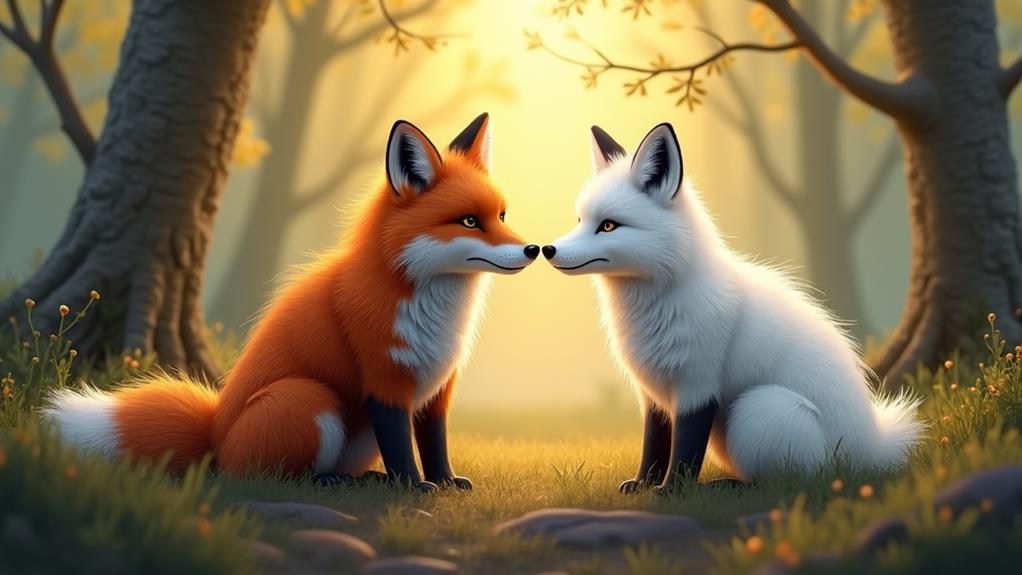
When you think about fox hybrids, you might picture a quirky mix of Arctic and red foxes, right?
These fascinating creatures have unique traits from both parents, making them a sight to behold.
While their love stories began back in 1929, most hybrids hang out in captivity since they can't reproduce, and their wild counterparts remain just as charming as ever.
Hybridization in Captivity
In captivity, red foxes and Arctic foxes can produce hybrids, though this phenomenon mostly occurs in controlled environments like fur farms. This hybridization is often the result of artificial insemination—an unusual method for animal breeding, but a key player in creating unique fox hybrids.
So, what should you know about these fascinating fox hybrids?
- Hybrids are generally sterile, meaning they can't reproduce.
- The first documented case happened way back in 1929!
- Captive breeding emphasizes desirable traits from both species, like unique fur patterns.
- These fox hybrids showcase a blend of physical traits, from fur texture to body size.
- Most hybrids are found in captivity, making them less common in the wild.
While hybridization may seem like science fiction, it really happens under specific circumstances.
Because these hybrids can't reproduce, they raise questions about biodiversity and the importance of keeping species separate in nature.
However, understanding their existence in captivity can help you appreciate the complexities of animal breeding. Plus, who wouldn't want to learn about a furry mix of a red fox and an Arctic fox?
Characteristics of Hybrids
How do hybrids between red foxes and Arctic foxes stand out? You'll notice they blend characteristics from both species, creating a unique and fascinating appearance.
Generally, these hybrids have mixed fur textures and shades, making them a true sight to see! Their sizes can vary too, but expect something that's somewhere between a sleek red fox and a fluffy Arctic fox.
One thing to keep in mind is that these hybrids are typically sterile, which means they can't reproduce. This sterility often confines their existence to captivity, which makes them rare creatures.
When you hear them vocalize, you might notice night-time coos or the distinct gekkering sound when they're upset. It's like a blend of two symphonies when you think about it!
Their eye colors? Get ready for a surprise—brown, blue, green, or even a mix! And don't overlook those adorable noses, which can range from black to pink.
If you ever spot a hybrid, consider yourself lucky! Each one showcases the beauty of both red foxes and Arctic foxes, reminding us how wonderful nature's combinations can be.
Historical Hybrid Accounts
Documented accounts of hybrid foxes highlight intriguing intersections between Arctic and red foxes, showing that these unique creatures have been the subject of interest since at least the early 20th century.
The first recorded instance of hybridization happened in 1929 on fur farms through artificial insemination. Since then, researchers have been fascinated by these foxes.
Here are some key historical points about red fox and Arctic fox hybrids:
- The Golden Island breed was developed in Finland during the 1980s, showcasing the potential for hybrid vigor.
- Early research showed various physical and behavioral traits in hybrids, making them unique.
- Hybrid foxes are primarily sterile, but some female hybrids may be partially fertile.
- Most hybridization occurrences remain in captivity; you won't easily spot them in the wild.
- These encounters, fascinatingly rare, deepen our understanding of fox genetics.
It's thrilling to see how these hybrids emerged from unexpected pairings!
Whether you're a wildlife enthusiast or just curious, this intersection between red and Arctic foxes gives us insight into nature's creativity.
Who knew foxes could lead such fascinating lives?
The Role of Captivity
Captivity plays an essential role in the hybridization of red foxes and Arctic foxes, enabling breeders to create unique variations of these animals. You might be surprised to learn that natural mating between these two species hardly happens because of their separation in the wild. Instead, breeders rely on artificial insemination in controlled environments, allowing them to mix characteristics from both the red fox and the Arctic fox.
The first known red fox and Arctic fox hybrid appeared way back in 1929, showcasing a long-standing interest in this fascinating area of animal husbandry. Most hybrids are produced on fur farms, where breeders carefully select traits they want to highlight, like fur color or build. It's a bit like trying to bake the perfect cake—everyone's got their preferences!
However, these hybrids are usually sterile, which means they can't reproduce. This limitation keeps them confined to captivity, but it also gives researchers a chance to study their behavior and genetics. Who knows? Understanding these hybrids might help in nurturing them as unique companions in the future!
Characteristics of Hybrid Foxes
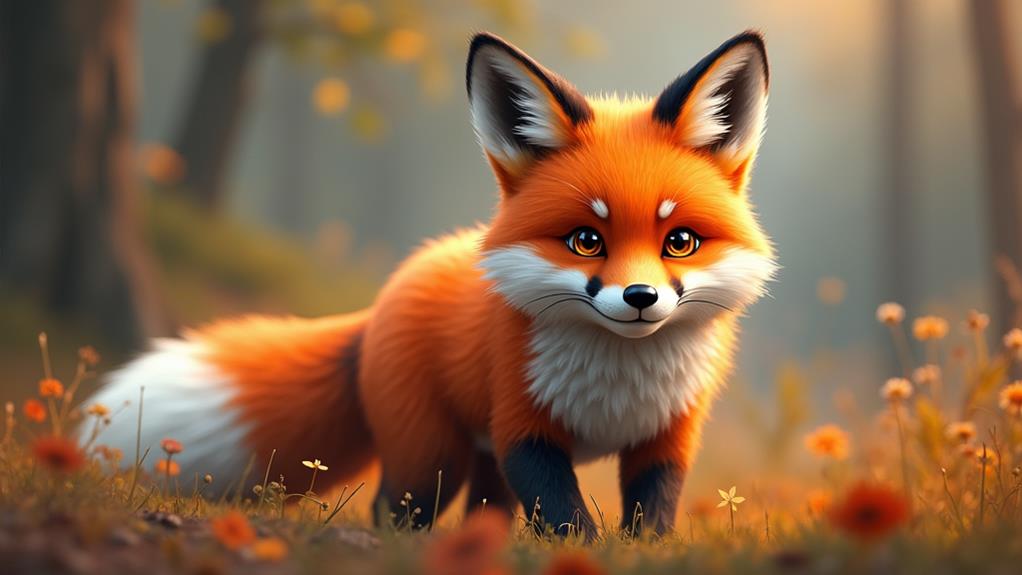
Hybrid foxes, the fascinating results of mixing red and Arctic foxes, showcase a unique blend of characteristics from both parent species. When you see these hybrids, you'll notice some intriguing traits that set them apart.
Here's what you might find interesting:
- Size: They usually have the size of a red fox, giving them a robust appearance.
- Fur Texture: Expect a mix of the thick, wooly underfur of Arctic foxes with the bushy tail of red foxes.
- Color Variations: Their fur can exhibit various colors, changing with the seasons as a nod to both parent species.
- Vocalizations: You'll hear a blend of sounds, from soft cooing when they're happy to gekkering if something makes them uneasy.
- Reproductivity: Most hybrids are sterile, but some female hybrids show partial fertility, which can create intriguing opportunities for breeding.
Through hybridization, these remarkable fox species combine attributes that enhance their adaptability.
Misunderstandings About Fox Hybrids
Misconceptions about fox hybrids are surprisingly common, often stemming from the visual similarities between different fox species. You might think that a red fox and a white fox could easily mix, but that's where things get tricky.
When folks talk about "white foxes," they often mean arctic foxes or specific color variations of red foxes. Science shows that red foxes (Vulpes vulpes) and arctic foxes (Vulpes lagopus) can hybridize because they're in the same genus, but they can't produce hybrids with color variants of red foxes.
You might picture adorable fluffy fox pups running around, but hybrids between red and arctic foxes usually end up sterile. That means no cute baby foxes for you!
The visual resemblance between these foxes often leads to confusion and dreams about their supposed hybrids.
Implications for Wildlife Conservation
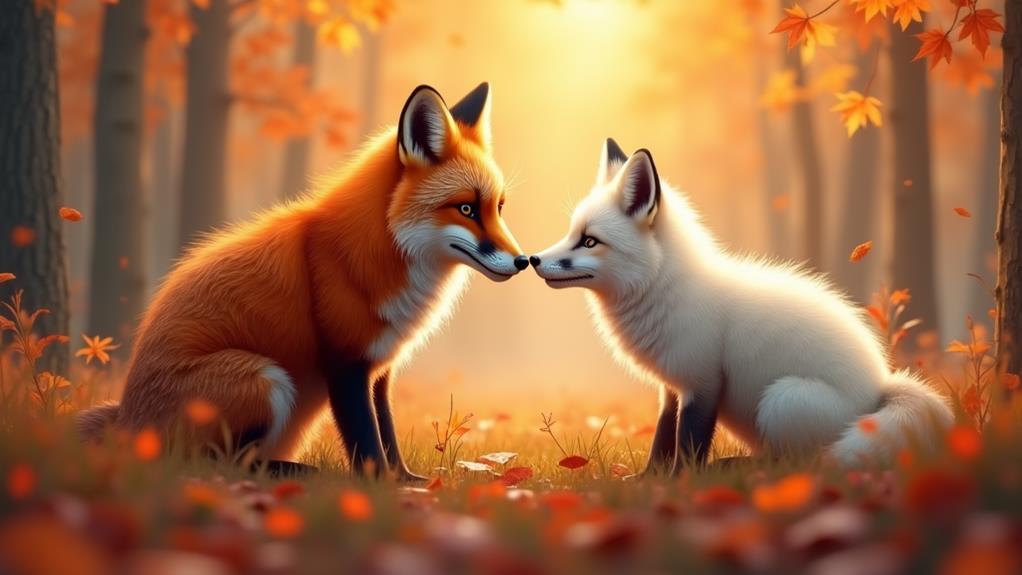
Understanding the implications of hybridization between red and Arctic foxes is essential for effective wildlife conservation. When these two species mix, it complicates efforts to protect both. Here are some key reflections:
- Genetic Integrity: Hybridization can dilute the unique traits of each species.
- Ecosystem Disruption: Hybrids might've different behaviors, impacting local wildlife dynamics.
- Habitat Preservation: Conservation plans must adapt to address the risks of hybridization.
- Impact on Native Species: The introduction of hybrids may outcompete local populations for resources.
- Conservation Awareness: Educating the public about hybridization helps sustain interest in protecting native foxes.
As you can see, this isn't just about cute animals; it's about preserving ecosystems!
We've to evaluate how hybrids affect genetic diversity and resilience.
Sure, hybrids might look charming, but they could challenge the survival of their wild counterparts and harm local habitats.
Popularity in the Exotic Pet Trade
The allure of owning a unique pet often leads enthusiasts to explore the world of fox hybrids, particularly the striking red and white varieties. Who wouldn't want a pet that's as beautiful as it's intriguing?
However, it's crucial to note that red fox and white fox hybrids, especially those involving Arctic foxes, are rare in the exotic pet trade. This rarity mostly stems from their specific breeding needs and the complexities involved in creating hybrids.
You might find domesticated variants, like silver foxes, more common than red and white hybrids. While the demand for unique colorations drives excitement, the market for these hybrids remains limited.
If you're considering taking one on as a pet, remember to navigate particular legal restrictions and ethical concerns surrounding wild species and hybrids. Plus, these fascinating creatures often have behaviors and care requirements that differ from traditional pets, meaning getting one isn't all fun and games.
Historical Accounts of Hybridization
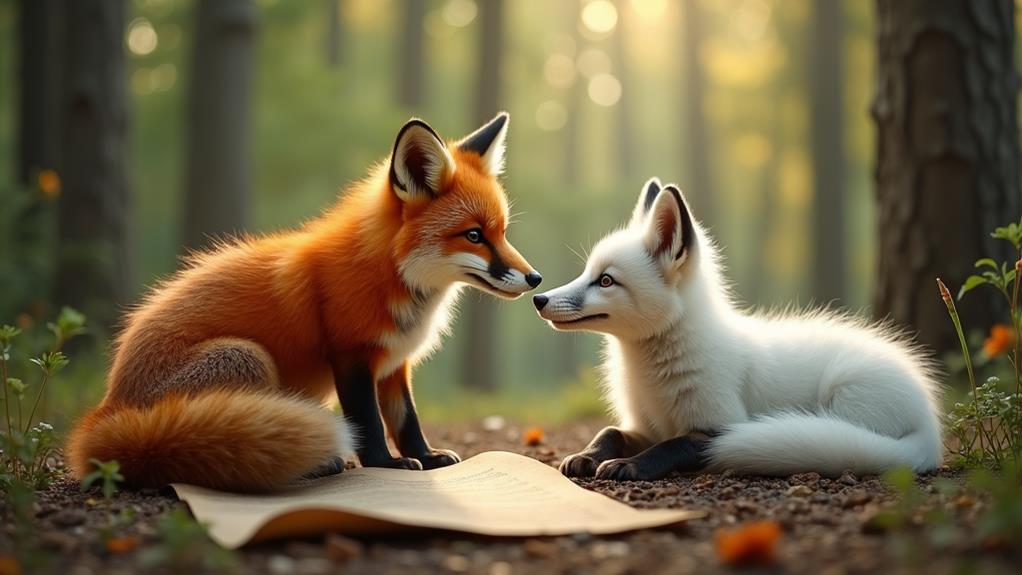
Throughout history, numerous accounts reveal the intriguing process of hybridization between red foxes and Arctic foxes. It all began in 1929 when the first documented case of hybrids emerged from artificial insemination in fur farms. While these curious combinations mainly occurred in captivity, they've sparked plenty of interest.
Here are some fascinating highlights about these hybrids:
- Early observations recorded larger hybrids, boasting robust traits from both species.
- Captive breeding creates opportunities for unique characteristics to flourish among hybrids.
- Historical documents detail various hybrid generations, exciting those passionate about animal genetics.
- Reports show that, despite their appeal, many hybrids are sterile, complicating further reproduction.
- Enthusiasts continue to study these hybrids, hoping to understand them better.
You see, hybridization between the red fox and Arctic fox isn't common in the wild due to their limited interaction. Yet, in captivity, they showcase a blend of beauty and strength.
Final Thoughts
In the end, the idea of a red fox and a white fox hybrid dances like a mirage in the wild—exciting but elusive. While nature has its limits, the fascination with these clever creatures continues to spark curiosity. Remember, though, hybrids aren't just a pet trend; they come with responsibilities. Whether you admire them from a distance or learn more about their unique traits, let's keep our appreciation for foxes as wild as they are!

